Reflecta Filmscanner RPS 10S test report
Im March 2025 the German company lanced a successor for the Reflecta RPS 10M on the market. The new RPS 10S replaces the old RPS 10M which was on the market for more than 10 years.
The predecessor RPS 10M was the top device for more than 10 years both from the house of reflecta and on the film scanner market in the medium price area. The new RPS 10S seems to continue this. If you look at the two devices outside, nothing has changed except for the label. Both scanners have exactly the same dimensions and also the same weight. Also if we compare the data sheets of the two scanners we only can find some marginal differences. The resolution remainas at 10000 ppi, the maximum density at 4,2. The RPS 10S can process the usual 35mm area of 36x24 mm.
We can find differences to the predecessor model rather in the software than in the device itself. There is a new featres with the name Multipass Exposure which is supposed to increase the daynamic range of the scanner by multi exposure. With another feature with the name Autocolor you can correct originals with strong tints. The RPS 10S can, as its predecessor, process not only film strips in batch mode but also complete film rolls. While the number of images is restricted to 3-36 at the RPS 10M, the new RPS 10S can process film rolls between 3 and 40 images. This is an essential advantage, because some old camera was able to put 37 pictures on a film with 36 pictures.
Features, accessories and performance evalution
The Reflecta RPS 10S has both a single slide slot for scanning one slide at a time, as well as a means to automatically load and batch scan 35mm film strips and 35mm roll films. With this feature it is one of the few film scanners offering the possibility of digitizing entire film rolls. The mechanics are the same as in the predecessor model: film strips are inserted sideways and then drawn in automatically. In addition, the film can be moved manually with the keys on the scanner case. Film strips must contain at least three images, otherwise they might get caught in the process. The upper limit of images for batch scanning is40 images. Since framed slides are inserted directly into the slot at the front of device, there is no need for film holders.

The Reflecta RPS 10S has a nominal resolution of 10.000 ppi. According to our experience the efftive resolution will be at about 50% of this number. The precise value shall be determined in our resolution test. There are no surprises to be expected in terms of density range, neither, as the producer states the value to be Dmax=4.2. Just like it's predecessor, the RPS 10S is equipped with a USB 2.0 port. The cable is included in the box. It is reasonable to ask why the Scanner was not fittet with a USB 3.0 port instead. Considering the fact that the data transfer takes up only a tiny fraction of the scanning time, the USB 2.0 port is absolutely sufficient.
The Reflecta RPS 10S includes a hardware based dust and scratch removal function. This precedure is called MagicTouch at reflecta. Within this procedure the film is scanned with the help of an infrared sensor. If this sensor detects heights, it is dust, if it detects depths, it is a scratch. The detected positions will be corrected within the scan software automatically.
One of the most prime attributes of the reflecta RPS 10S ist the Auto-Fokus, distincly setting it apart from other Scanners in the same price range. Most other film scanners offer only a fixed focus, dictating the focal plane. Even a slight arch of a slide can result in fuzziness in the center of the scan. The auto-focus of the RPS however precisely determines the focal plane for each individual scan. Furthermore, the focal plane can be set manually via the scansoftware SilverFast. Currently, only a handful of scanners possess this feature, such as the professional models from Nikon or the Epson Expression 13000XL, all of which range in an entirely different price range.
Reflecta delivers the scanner with its own scan software CyberView. The software is provided at the manufacturer`s website. As an alternative there is the professional SilverFast scan software in different variants.
Installation and start-up of the Reflecta RPS 10S
With overall dimensions amounting to 274 x 183 x 97mm, the scanner is delivered in well-padded cardboard box of 41x36x20 centimeters. Given that the reflecta RPS 10M itself is a rather space-saving device with no need for film holders and negative carriers, there is not much room needed on the desktop.The software should be installed prior to connecting the scanner to the computer. If you use SilverFast as scan software you don't need to install CyberView at all, since SilverFast is scan software and scanner driver together.
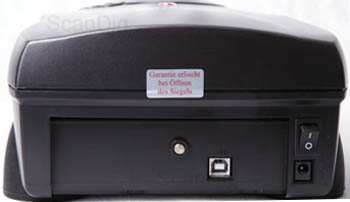
Both CyberView and SilverFast offer regular updates. That is why it is recommendable to ensure that the running version of the software is up-to-date. Software updates take place free of charge through the respective producers' homepages. Once the software has been successfully installed and checked for updates, the scanner is to be connected to the power grid up using the mains cable and connected to the PC via the USB cable - both part of the delivery scope. Its advisable to avoid the use of any USB-hubs or -extensions, as this often leads to complications. Furthermore we do not recommend to use an USB cable which is longer than the one supplied with the device, as this too might lead to communication issues between the scanner and the PC.
The scanner is powered up through a small flip switch at the rear end of the device. The scanner is ready for operation immediately, the green LED at the front side of the scanner illuminates constantly. If you want to check if the scanner has been found by your PC you open the device manager within Windows and open the list of Imaging processing devices. There you should find an entry for the RPS 10S like this: Multiple Frames Film Scanner.
Scanning film strips with the Reflecta RPS 10S
The Reflecta RPS 10S has an automatic film strip feeder and film strip transport mecanism. In this aspect it distinguishes from many other devices, which can process film strips but cannot feed and transport them automaticaly. The concept of automatic drawing-in and batch scanning film strips suggests the main purpose to be the scanning of film strips. Film strips of 3 to 40 imgaes can be batch-handled. The predecessor model RPS 10M could film strips only up to a length of 36 frames. This saves the user the manual positioning of film holders, as well as the advance of the latter by hand. Once the scan process for several pictures has been started, there's no need to sit and wait - instead, this time can be spent more purposefully. The film is being inserted into the designated slit to the side of the scanner, automatically drawn in and transported further by means of its perforation.
For inserting film strips, we highly recommend the use of cotton gloves, as this will guarantee the safe handling of precious film material, preventing polluting or damaging it. As the transport mechanism of the scanner relies on the perforation, it is vital for this to be fully intact. In case of a partial damage of the perforation, it is reccommendable to cut the film into single frames which can then be framed and digitized individually. Those dealing with entire film rolls of up to 40 frames in mind should consider themselves fortunate as they will benefit from the true virtue of the RPS 10S. We will elaborate further on this within the next chapter.
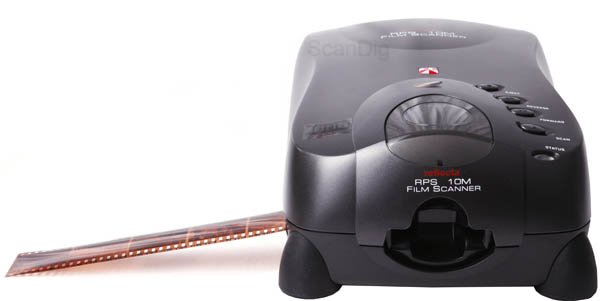
Once the film strip is inside the device, the index scan can be started in the software. This helps to keep track of the images contained on the Film strip. As our spread sheet reveals, this is accomplished quickly in SilverFast, whilst CyberView performs rather sluggish due to the fact that it performs a full preview scan of each frame. Since it will always be automatically inverted in the case of negatives, this preview is then present in the form of a positive, making it to take one's pick. Prescans of single images can subsequently be made in SilverFast - or invoked by clicking on the miniatures in CyberView. Alternatively, the final scan can be started right off. What matters here is whether there are adjustments to be made beforehand. Scanning the image into RAW-format through SilverFast (HDRi), renders this unnecessary. We will take a closer look on available options in the respective software within the chapter image quality image quality in conjunction with SilverFast.
The film strip is inserted horizontally into the scanner and treads out just the same. This is a key advantage, especially if a film strip is slightly waved, as the film strip does not have to be deflected but only transported horizontally. When dealing with waved negative strips, the negative transport poses to be beneficial too, as the insertion and draw-in into the left slit proves to work very well.
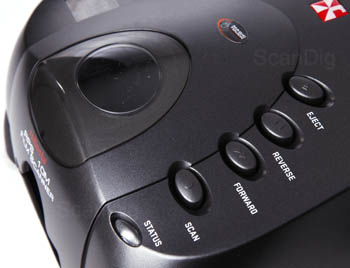
On top of the scanner, there is a small window through which the currently positioned film can be seen. Nevertheless, due to the dim lighting, it is necessary to do a previewscan or indexscan. The quick scan button atop the scanner can be used only in conjunction with CyberView - it has no function within SilverFast. In the case that a film strip has been mal-positioned, these buttons can be used to forward and rewind it, the function being much like that of a VHS recorder. The film is being moved in tiny increments which allows very precise readjustments. Upon prolonged pressing of one the abovementioned keys, the film will advance or rewind for an entire frame. The eject key will - naturally - eject the film.
Users wanting to clean their negative stips in beforehand in order to achieve better scanning results, can do this for example using an anti static brush. This does not only reduce potential artifacts that have been missed by the automatic dust- and scratch removal, but also treats the scanner with care. Even some smallest dust particles inside the scanner can cause problems over time. If too much dust accumulates in a certain place, this can lead to banding in resulting scan files.
If dust has gathered on the sensor, the scanner may be cleaned using a compressed air spray.
One of the easiest ways of cleaning film strips before feeding them into the scanner is the use of a Kinetronics anti static film cleaner MiniStat MS-035, which you can see in the following picture.
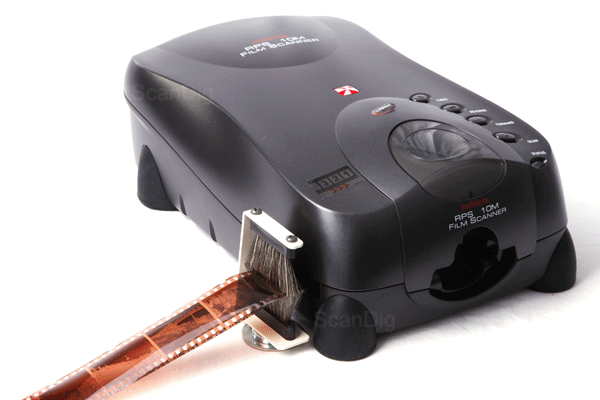
The MiniStat film cleaner can simply be placed next to - or attached to the left side of the scanner. The magnetic base of the MiniStat ensures a flexible, yet stable mount on the working desk. A hinged metal plate is supplied with the product. A common flat washer from the hardware store or an adhesive strip will work just as well.
The film is threat through the fine fibers consisting of electrically conducting synthetic. In this way, dust is being removed and the material is discharged from electrical charge. As discharged film strip will naturally attract less dust particles, the cleanliness will last longer. Since the entire film strip passes through the MiniStat before entering the scanner, every frame will be cleaned from dust. Caution is required if the film is being rewinded, eg. after an index scan, as this can lead to jamming in case the film does not find the way through the brush.
Scanning film rolls with the Reflecta RPS 10S
Besides the Reflecta RPS 10S only the Nikon Super Coolscan 5000 ED, in conjunction with the optional Adapter SA-30, can process entire film rolls at once. All other film scanners are limited to six images. While the predecessor model Reflecta RPS 10M was able to process film rolls only up to a length of 36 frames, the new Reflecta RPS 10S can handle film rolls up to a length ov 40 pictures in batch mode.
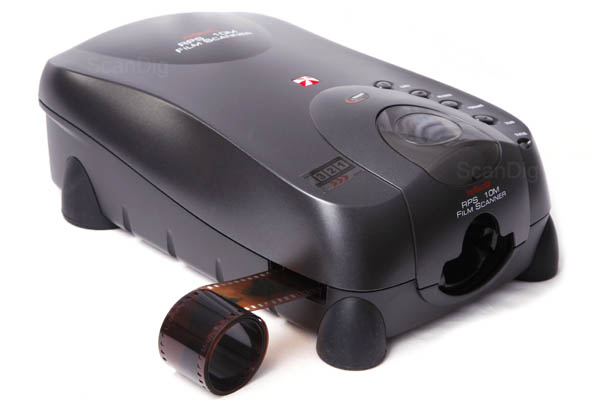
The Reflecta RPS 10S can automatically draw in and batch scan an entire film roll. It is important though that there is sufficient room on the desk left and right to the scanner (since the film roll is being ejected in the same way as it is inserted). Thus, a major part of the unrolled film will always stay on one side of the device, its placement should be carefully chosen and the process should be monitored with equal care.
Although our experience shows, taht entire film rolls are usually strongly domed, the RPS 10S handles them very well. The insertion of the film into the scanner is just marginally more complex than with smooth film strips, and once the scanner has registered the entire roll, we are ready to roll, so to say. The scanning process does not differ from scanning of seperate film strips. The index scan works just in the same way, as does the prescan.
Actually, the Reflecta RPS 10S is the only film scanner to draw in and batch scan entire film rolls of up to 40 images.
For the sake of completeness it should be noted that the Nikon Super CoolScan 5000, in conjunction with the optionally available Nikon film roll adapter SA-21-30, as the only alternative, can also handle entire film rolls. In terms of price and quality, this combination ranges in a completely different league.
Scanning 35mm framed slides with the Reflecta RPS 10S
Scanning of framed 35mm slides is very simple, as there is no need for dealing with frame holders and frame thickness. With an acceptable maximum frame thickness of 3,5mm, all common 35mm frames are covered. A recessed slot can be found at the front of the scanner. When there is no slide injected, this slot closes itself. It is also self-adjusting to the thickness of the frame, thus nothing has to be regulated manually.
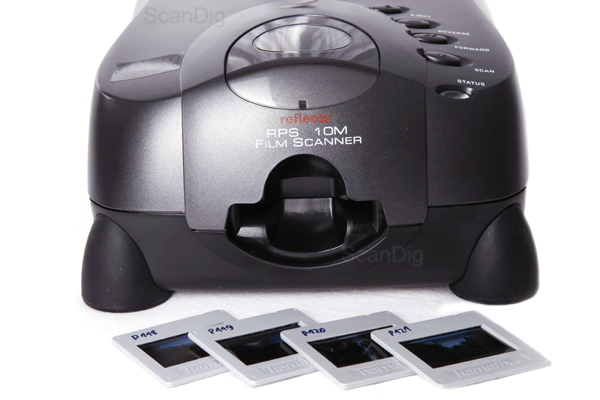
Owing to the scan area, the slide has to be inserted in landscape format. Portrait formats can subsequently be rotated within the scan software. In case of a slide is inadvertently injected in portrait format, it will be clipped on the top and bottom. Also, a black edge will be visible at the left and right side of the image. The quick and simple process of inserting a slide into the RPS 10S can be seen in animation.
With only one slide being inserted at once, the necessitiy of index scans is eliminated. Besides that, scanning of framed slides passes off fairly similar to the scanning of film strips. If necessary, a prescan is run, after which software parameters are adjusted, followed by the main scan. The available software parameters depend on the scanning software at hand. Whilst CyberView is a bit limited in this regard, SilverFast offers a wide range of options. We will delve deeply into the destinction between SilverFast and CyberView X, as well as the qualitative advantages of SilverFast in terms of scan quality, in the chapters scan software and image quality.
Scanning single negatives and positives with the RPS 10S
As you saw, scanning of single framed slides and film strips with three pictures or more is plain very simple. Scanning single negatives or strips of two images is somewhat more tricky. Trying to do it using the automatic draw-in involves the danger of jamming and potentially damaging the film strips.
Such short film strips, as well as single images, should rather be framed beforehand scanning. Best suited for this purpose are the Wess AHX500K frames, as they allow for the full frame to be seen and scanned, hence there won't be any clipping issues as can be the case with most other types of slide frames. The hinges of the Wess AHX500K are very durable, as is the snap-lock, guaranteeing a long lasting and uncompromising functionality, even if it is frequently opened and closed. Two rows with 8 cams each keep the film plane and steady. If the Wess AHX500K are a tad too much for your budget, try the Reflecta CS2 slide mounts instead. They will also do the trick but wear out faster if opened and closed frequently.
Scanning other film format with the Reflecta RPS 10S
Scanning other film formats such as Instamatic, APS, Pocket or medium format is not possible with the RPS 10S. The device is built to handle 35mm small format films only with the scan-area measuring 24.3 x 36.5 mm and the film transport relying on the specific perforation of this film.
Film formats smaller than the 35mm format can be digitized only if mounted in 35mm frames, which is a lot of hassle. Our scan service would surely be much more convenient for those special formats.
Scan-Software of the Reflecta RPS 10S
We offer the Reflecta RPS 10S both with the scan-software from Reflecta CyberView X and with the professional scan software SilverFast from LaserSoft Imaging.
Manufacturer's scan software CyberView X
The standard scope of supply includes the reflecta scan software CyberViewX (Version 5.16.50 for Windows in our case). Optionally, the scanner can be purchased with one of the four SilverFast versions SE, SE Plus, Ai Studio and Archive Suite. We explain the key differences between the different SilverFast versions in our chapter Questions about the scan software SilverFast.
The software CyberView X is the software of the manufacturer. It can be downloaded at the manufacturer's website for free. After the start of CyberView X one can choose between the languages German, English, Japanese and simple Chinese. After starting the scan software the scanner initialices and you can hear some soundes from the scanner. After less than half a minute the scanner is initialized and ready for operation. The scan software window appears.
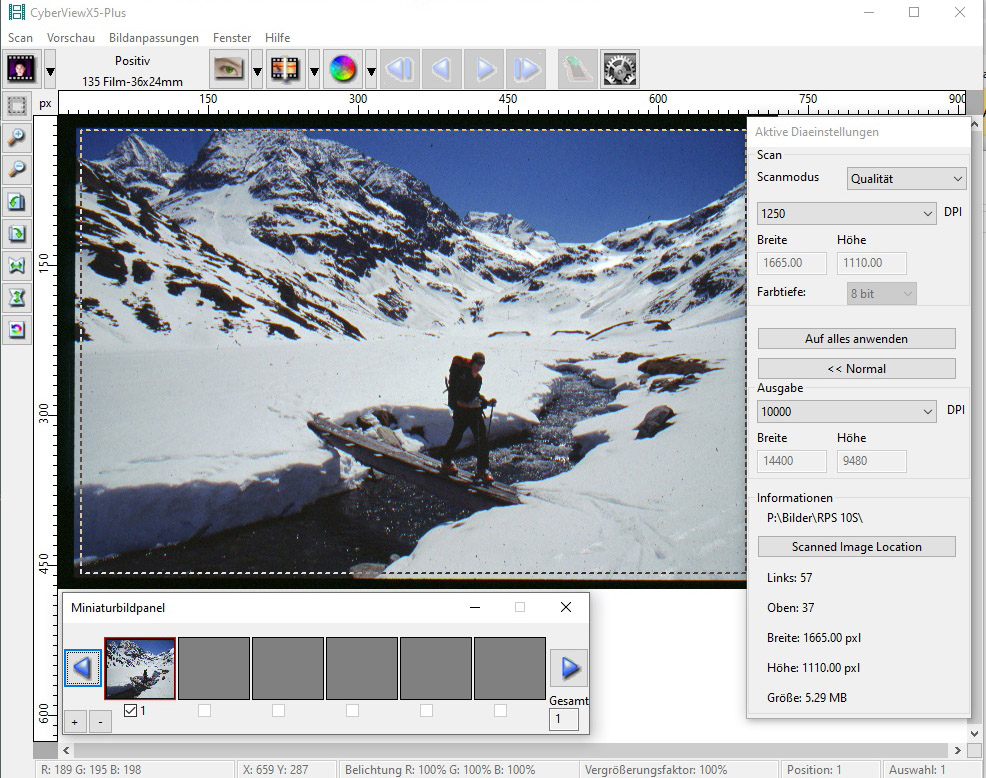
CyberView X is a very simple scan software with a small number of functions for image editing and image optimization. Due tu this simpleness the scan software is very easy to handle and to learn. At the main menu bar you can find a button for creating a prescan and another button for starting the scan. You may only use these two buttons in order to create good scans very quickly.
Evidently, CyberView offers only limited means of manually optimizing the pictures. The only tools for manual adpation are the so-called variations, the color balance, the curve and levels. With the variation function, color and brightness can be controlled through small preview pictures. The color balance consists of three color controllers, (CMY/RGB), and then one each for bightness, contrast, and saturation. Through the curves- and levels-tool, both gradation and tonal values are controlled. Unfortunately, not all tools allow precise adjustment. What's more, tools like selective color correction are not even available.
CyberView does indeed offer only little manual control. Instead, there are lots of automatic functions at disposal. Besides auto exposure, auto balance, auto contrast and auto color, there is even auto cut. A good deal of functions which all work more or less. As with all automatic correction features, one should never rely on them to actually improve the pictures. The reddish evening light, for exapmle, can never be interpreted as such by an auto-correcting function. Neither can be the yellow warmth of candlelight on a christmas tree, which is why such features should be treated with caution.
For the image output the user can choose between JPG, TIF and DNG. While the TIF format creates uncompressed files, for the JPG-format different levels of compression can be chosen. The output resolution can be manually set up to the nominal resolution of 10.000 ppi.
The Reflecta RPS 10S is being shipped with the rather simple scan software CyberView X. Quick and easy to master, this software comes in handy for beginners, but lacks technical possibilities of image optimisztion for advanced users.
SilverFast scan software from Lasersoft Imaging
For the Reflecta RPS 10S there is also the professional scan software SilverFast Ai Studio from the German software manufacturer Lasersoft Imaging. If you purchase the RPS 10S bundled with the professional SilverFast scan software, you will receive the best scanning software presently availble on the market. Not only does SilverFast Ai Studio greatly impress with a huge functional range for optimizing the scans. Also the image processing algorithms do a much better job than those of CyberView X. We elaborte further on the differences between the two software in the chapter image quality, clearly revealing them by means of example pictures.
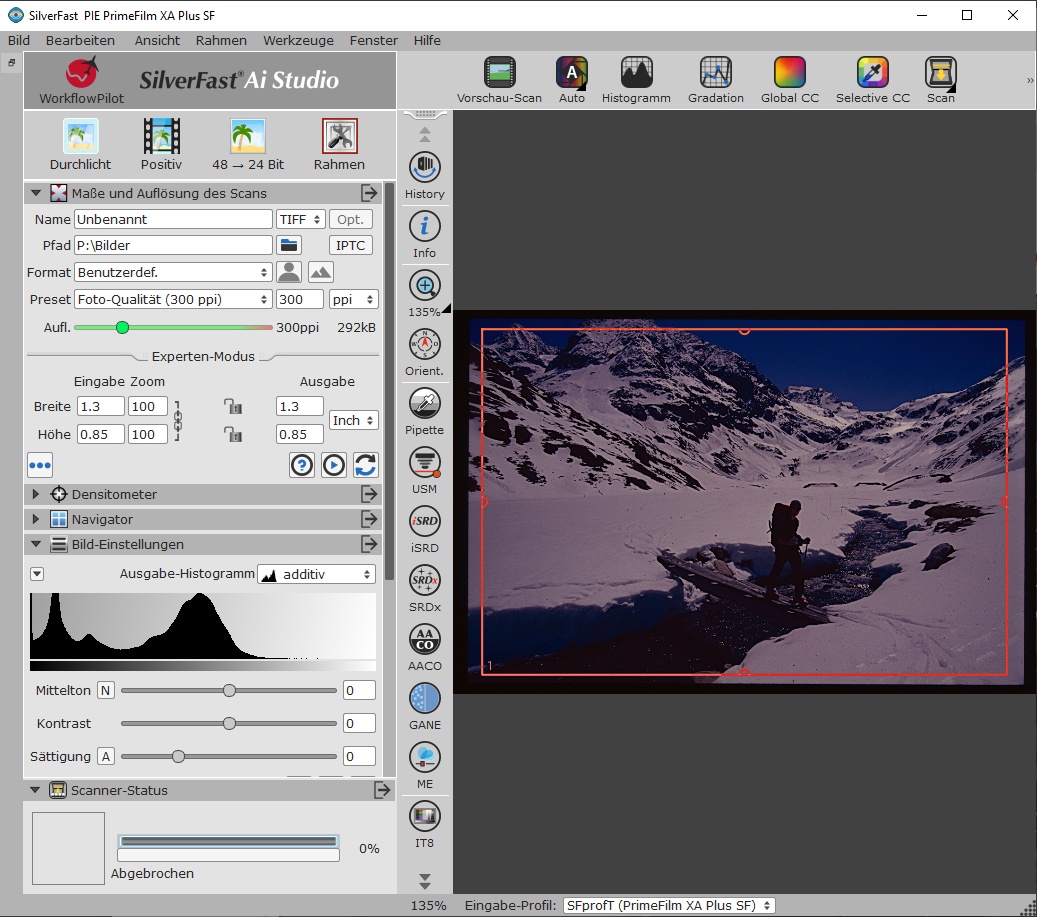
We recommend to operate a high value scanner like the Reflecta RPS 10S with the professional scan software SilverFast Ai Studio. SilverFast offers uncountable seeting possibilities for optimizing the scans and yields a better image quality than CyberView X. Furthermore you can perform a colour calibration within SilverFast Ai Studio using IT-8 calibration targets and so correct the colour errors, which every scanner has, once at a time. The functional range and the possibilities of SilverFast are so huge, that we cannot list them in detail here. We refer our special website about SilverFast.
Image quality of the Reflecta RPS 10S
The Reflecta RPS 10S has a nominal resolution of 10.000 ppi. If you digitize a 35mm film with thi resolution you will receive an image file with about 14170 x 9450 pixels. In total that`s about 134 million pixel, thus 134 megapixel. This is a huge quantity of data, which the RPS 10s creates from a 35mm film. The 10.000 ppi are the optical resolution of the scanner, i.e. the resolution with which the scanner samples the film. In order to find out which resolution the scanner yields in practice we make a resolution test using an USAF test chart. Please find more information about it on our website about resolution.
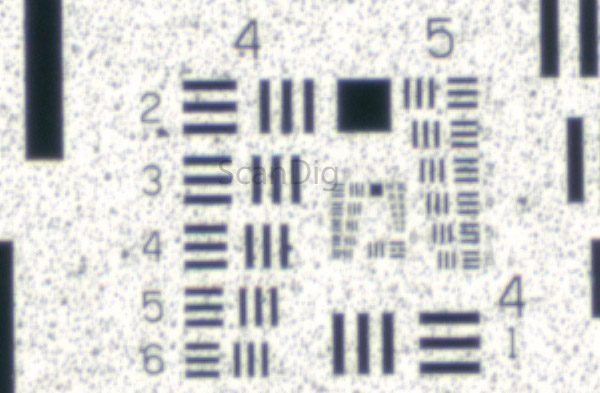
In the image you can see the inner part of the USAF target in original size. We can recognize 3 bars of the element 6.3 both in horizontal and in vertical direction. According to our USAF resolution table this corresponds to a resolution of 4096 ppi. Compared with the nominal resolution of 10.000 ppi this means that the Reflecta RPS 10S achieves about 41% of it in practice. So the resulting scans, which contain 135 megapixel, consist effectively of 22 megapixels. The other pixels are double or multiple.
An effecite resolution ov 4096 ppi is a very good value, since you can extract all the image information of a 35mm film, which it contains. If you haven`t taken your photos with a high-value SLR and used high-value lenses, you won't have films which contain 20 million different pixels. It is annoying that the Reflecta RPS 10S yields image files which are blown-up, and you have to compress them after scanning in the image editing software.
The Reflecta RPS 10S has an effective resolution of 4100 ppi ans do achieves about 41% of its nominal resolution of 10000 ppi. Nominally the scanner produces image files with 134 megapixels, effectively the scans contain about 22 megapixels.
With an effective resolution of 4100 ppi the Reflecta RPS 10S exceeds the long-term leader Nikon Super Coolscan 5000ED, which yields "only" 3900 ppi. While the Reflecta RPS 10S achieves its 4100 ppi with nominal 10000 ppi, the Nikon 5000 achieves its 3900 ppi with nominal 4000 ppi. The essential quality difference between these two devices becomes apparent when comparing the 41% per cent of the nominal resolution of the Reflecta RPS 10S with the 98% of the Nikon Super CoolScan 5000 EE..
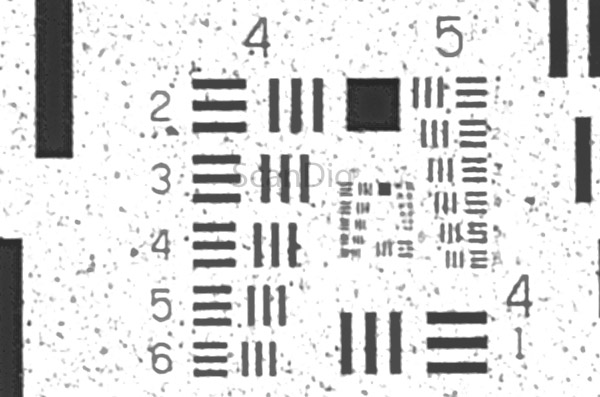
We have done another resolution test using SilverFast AI Studio. The image shows again the inner part of the USAF target, which was scanned with 10.000 ppi. You can recognize the 3 horizontal bars of the element 6.4 and the 3 vertical bars of the element 6.5 These values correspond to an effective resolution of about 4800 ppi. This value surprises much, because it is by 700 ppi higher than the value with CyberView X. We cannot explan this phenomen.
The Reflecta RPS 10S achieves a significantly higher effective resolution of 4800 ppi with SilverFast Ai Studio compared to the 4100 ppi with CyberView X.
When comparing the reoluts of our resolution tests with them of the predecessor model we recognize small differences although the two models are quite identical. At this point we want to emphasize that we make our tests with one device. We don't calculate any average values from a series of scanners. The real resolution of another RPS 10S may vary from our test results.
In order to evaulate the color representation of the scans with the Reflecta RPS 10S we have made some scans with slides and negative film strips. When doing this we could not notice any differences to the predecessor model RPS 10M. The reults of the scans with SilverFast AI Studio and IT8 colour calibration are quasi identical. With CyberView X there are some small differences visible, however they indicate less to the differences beween the two models than between different deives. An IT-8 colour calibration is done especifically in order to eliminate such differences between different devices by bringing each device to a specific colour standard.
Since the image quality of the Reflecta RPS 10S does not really defer from that of the predecessor RPS 10M we won`t publish a separate chapter about it but refer to our review of the RPS 10M with the chapters Image quality with CyberView and Image quality with SilverFast.
Scanning speed of the Reflecta RPS 10S
In order to measure the scan speed we scnned several positives and negatives with different solutions. The following spredsheet displays the measurement results of scans with CyberView and SilverFast Ai Studio:
| Procedure |
Duration with MagicTouch (CyberView) |
Duration with iSRD (SilverFast) |
| Prescan |
0:48 min |
0:25 min |
| Index scan for 6 negatives |
5:30 min |
2:05 min |
| Positiv scan with 5000 ppi resolution |
2:17 min |
2:25 min |
| Positiv scan with 10000 ppi resolution |
1:45 min |
2:48 min |
| Nositiv scan with 10000 ppi resolution |
7:45 min |
4:36 min |
First and foremost, the tabular values show that the preview for a single frame takes half a minute, which is reasonable. Ater that you make your desired settings and start the main scan. If you work with film strips you start with making an index scan, i.e. you make a mini scan from each picture on the film. Such an index scan takes more than 5 minutes with CyberView X for a film with 6 pictures, and within SilverFast more than 2 minutes. These times are very long if you consider that a Nikon scanner could make that within a few seconds 25 years ago. After the index scan you make the desired settings for each picture and then start the batch scan.
The measured scan times for a mounted 35mm film (positive) are in the field of 2-3 minutes, depending on the settings in the scan software. Tht's a good value. The predecessor RPS 10M was significantly slower. When doing negative scans, however, the scan times are significantly higher. Also compared to the predecessor the measured scan times are higher. If you scan a film strip with 6 pictures in the batch mode you can leave the scanner and the computer for about half an hour. The scan procedure works automatically, you don't have to intervene.
Conclusion, summary
The Reflecta RPS 10S is characterized by its ability to scan film strips and film rolls containing between 3 and 40 pictures in one go. While there is a batch mode for film strips, mounted slides can be inserted and scanned only one by one.
The Reflecta RPS 10S is distinguished by its high image quality and high resolution. The image quality and the resolution can be increased significantly if the scanner is operated with the professionel scan software SilverFast Ai Studio. Another feature which distinguishes the Reflecta RPS 10S and sets it apart from other scanners, is the autofocus and the manual focus. The device works very fast, but makes loud noise.
We recommend the Reflecta RPS 10S to anybody who wants to scan slides and film strips in high quality. Especially when scanning film strips this device has an essential advantage over other scanners thanks to the automatic feeder.
Back to the film scanner tests index
|